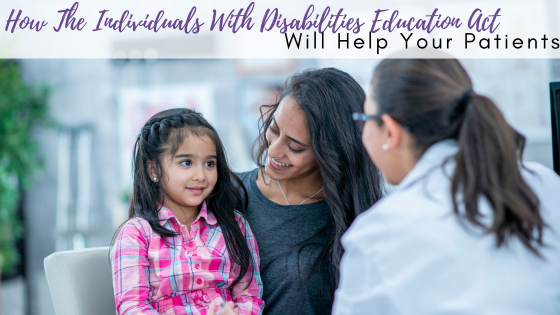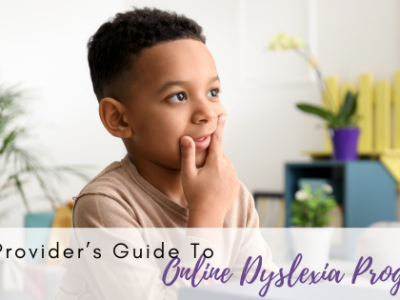
How The Individuals With Disabilities Education Act Will Help Your Patients
One of the greatest things about working as a medical provider is meeting all kinds of patients with all different kinds of abilities. Working with children who are diagnosed with a disability can be enlightening and enriching for physicians. It opens up a whole world of understanding and connection. For patients who have specific learning disabilities like dyslexia, speech, language, visual, or hearing impairments, autism, traumatic brain injury, intellectual disabilities, emotional disturbance, or ADHD, there is a wide range of benefits offered to them under the Individuals with Disabilities Education Act (IDEA). This act helps to ensure that young students with disabilities have the opportunity to reach their full potential as they move through the public education system. As a practitioner, it is important to know about this key piece of federal legislation that you will likely encounter or refer to throughout your practice and interactions with patients. Read on to learn more about how the Individuals with Disabilities Education Act will help your patients.
- It emphasizes a right to education. IDEA guarantees that all children with disabilities—no matter the severity—have the right to a free and appropriate public education; this is known as FAPE. This education must also happen in the least restrictive environment (LRE). LRE is aimed to focus on inclusion, meaning that students will have access to quality education alongside their non-disabled peers whenever it’s possible.
- An early start is essential. IDEA is focused on early intervention for students. The early identification of a disability can help to expedite the addition of support for students at school. This timing can truly change a child’s trajectory of learning and success in the classroom.
- IDEA aims to individualize education. For students with disabilities, IDEA mandates that an Individualized Education Program—also known as an IEP—be created. An IEP is a tailored plan that outlines a student’s specific needs, goals, and any accommodations that are required for his or her success in school.
- It provides access to services. IDEA is meant to ensure that students with disabilities are able to have access to a variety of special education services that they may need. Some services may include: speech therapy, occupational therapy, physical therapy, or counseling. Altogether, these services help to address the individual needs of students, and they support students in overcoming some of the challenges that are connected to their disability.
- IDEA allows for technology. The world is relying more and more on technology, and in the world of students with disabilities, there are plenty of programs that can provide great benefits. IDEA allows schools to use assistive technology to help students with disabilities. Some examples of tech used in the classroom include: specialized software, communication devices, or adapted learning materials.
- It ensures that educators are qualified. An important aspect of IDEA is that it aims to have qualified special education teachers as well as trained service providers who are able to meet the diverse needs of students with disabilities. This helps students to have effective instruction.
- IDEA has a plan for the future. Students with disabilities may need help with transition planning as they move from school to other real world settings. IDEA requires schools to develop plans to help prepare students for more education, employment, and independent living; all of this focuses on long-term success for the students.
- Parents are part of the plan. Much like your patients’ overall health journey, parents are part of students’ education journeys too. IDEA encourages the involvement and active participation of parents in their children’s education. Parents are part of the IEP process, and they can also work with educators to ensure that students are getting the support they need at school.
- Mediation is part of IDEA. Sometimes disagreements or conflicts may arise when it comes to a student’s IEP or placement. IDEA has a process for resolution when parents and schools may disagree, and it ensures that parents can advocate for their children.
- Data is key. IDEA outlines that collecting data on student progress helps to monitor performance, identify areas for improvement, and focuses on the effectiveness of educational services for students with disabilities.
In an ideal world, the benefits of IDEA would be all-encompassing and empowering, ensuring success for all students. But sometimes, students with disabilities like dyslexia need more help than what is offered at school. One solution to help students to achieve academic success and confidence comes in the form of dyslexia therapy.
Dyslexia therapy is different from typical solutions for dyslexic students. Dyslexia on Demand is a specific dyslexia program that uses Certified Academic Language Therapists (CALTs). CALTs are specially trained to work with students. Through Dyslexia on Demand, CALTs and students work together online, using Orton-Gillingham based intervention programs. Frequent sessions of dyslexia therapy help to provide diagnostic, explicit, multisensory instruction in one-on-one or group therapy settings. Working together multiple times per week helps to encourage the development of accuracy, fluency, and comprehension for students with dyslexia.
Does your student with dyslexia need a more personalized plan? Reach out to the experts at Dyslexia on Demand. They can help you to learn more about dyslexia therapy and all of the benefits it offers as it helps to alleviate your student’s struggles with learning.







